 Website:
ZwickRoell GmbH & Co. KG
Website:
ZwickRoell GmbH & Co. KG
Group: ZwickRoell Group
Catalog excerpts
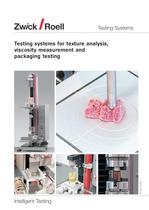
Testing systems for texture analysis, viscosity measurement and packaging testing FP 485 2.0409 Intelligent Testing Testing Systems
Open the catalog to page 1
2 The Zwick Roell AG – More than a century of experience in materials testing Mechanical-technological testing is one of the oldest disciplines of materials testing. As early as in the 15th and 16th century, Leonardo da Vinci and Galileo Galilei were already considering the flexural stressing and the elastic behaviour of materials. In the course of time further knowledge was obtained. In the middle of the 18th century the first testing machines finally appeared in France. Since 1920 the company Roell & Korthaus has been involved in the materials testing business. In 1937 Zwick built it...
Open the catalog to page 2
4 The instrumental texture analysis removes all elements of subjectivity from the testing. Measurement methods are used which, although introduced internationally, are rarely standardised. The main problem of texture analysis is that the shape and consistency of foodstuffs deviates very much. Reproducible results require a careful preparation of specimens and the testing method. Carefully prepared specimens and tests can, quite often, lead to surprisingly high correlations to sensory tests. Variances in product quality are much more apparent since they are determined by a texture analyser...
Open the catalog to page 4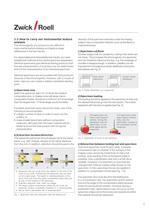
5 A B C D 1.2 How to carry out instrumental texture analysis The inhomogenity of a product is very difficult in instrumental texture analysis and leads to large differences in the test results. For dependable and interpretable test results, you need suitable test methods and a careful specimen preparation. Identical specimens give identical starting points so that the real characteristics of a product can be determined, and not the characteristics of an individual specimen. Identical specimens are not possible with food products because of the inhomogenity. However, with a couple of basic...
Open the catalog to page 5
6 F13 F14 F11 F12 F15 FV - FV S16S11S12 S15 S13 S14 s1 F23 F24 F25 FV - FV S26 S25S23 S24 s2 S20 E11 E13 E14 E22 E21 E24 E23 E12 1.3 Test software testXpert® II: Test sequence and results Cyclic tests simulate chewing (fig. 1). In the first compression phase the specimen is loaded up to a preselected strain. The specimen is released in the following tensile phase. The energy under the force travel curve is split through the maximum force into two parts (see fig. 2). The second cycle runs in the same manner. The number of cycles depends on the specimen: two or more cycles are possible, in...
Open the catalog to page 6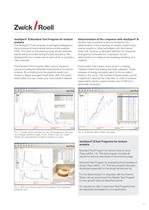
7 testXpert® II Test Programs for texture analysis Standard Test Program for texture tests on food (Type xct054_14): This test program includes all results for tests as described on the previous page Standard Test Program for evaluating the properties of dough (Type xte051_47): This test program has been developed especially for the dough tensile test rig For the determination of crispness with the Kramer Shear cell we recommend the Master Test Program for tear growth tests as described above On request we offer Customized Test Programs that are especially developed for your application....
Open the catalog to page 7
8 (1 American Association of Cereal Chemists Foodstuff Test method Determined characteristics Bread and baked goods Bread, cake Cyclic compression or penetration test Firmness, Gumminess, Springiness Bread slices AACC 74-09: Penetration test with cylindrical die Firmness, Hardness Pastry, cookies, waffles Warner-Bratzler shear test Firmness, Bite Characteristic 3-point flexure test Hardness, Fracturability, Brittleness Dough Dough tensile test Extensibility, Elasticity, Stickiness Penetration test with ball die Softness, Stickiness, Cohesiveness Snacks Peanut flips, chips, Shear test with...
Open the catalog to page 8
9 Kramer Shear Cell The Kramer shear cell simulates a single bite on foodstuffs and provides information about bite characteristic, crispness and firmness. It is used for meat and fish products, small sized fruit and vegetables as well as for cereals and snacks like potato chips. The 5 or 10 shear blades drive at a constant speed through the specimen material, compressing, shearing and extruding it through the slotted base. The test is made on a defined sample quantity. The multiple blades provide a measurement on several positions at the same time thus local texture deviations are...
Open the catalog to page 9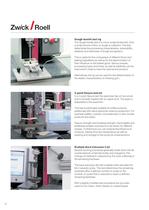
10 Dough tensile test rig The dough tensile test is a micro-scale tensile test: Only a small volume of flour or dough is sufficient. The test determines the processing characteristics, extensibility, elasticity and stickiness of dough and glutens. This is useful for the comparison of different flours and baking ingredients as well as for the determination of their influence on the baked good. Various recipes, processing types and times, as well as additives can be improved in order to have the optimal end product. Alternatively the rig can be used for the determination of the elastic...
Open the catalog to page 10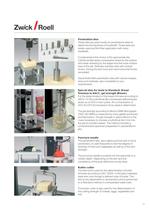
11 Penetration dies These dies are used mostly for penetrations tests to determine the hardness of foodstuffs. These tests are widely used and find their application with many foodstuffs. Fundamental is the choice of the appropriate die: Cylindrical dies apply compressive stress by the surface and shear stressing by the edges and the outer surface area of the die. Whereas ball dies start with vertical forces. During the test more and more horizontal forces are added. Zwick Roell offers penetration dies with various shapes, sizes and materials, also completely to your requirements. Special...
Open the catalog to page 11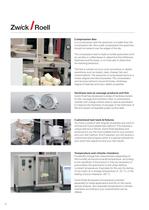
12 Hardness test on sausage products and fish Zwick Roell has developed a range of hardness testers for fish, sausage and luncheon meat. A compression cylinder with a large surface area is used as penetrator to measure the hardness of sausage or the freshness of fish and obtain comparable quality control data. Compression dies In a compression test the specimen is smaller than the compression die. Also under compression the specimen should not extend over the edges of the die. The compression test is made on brittle specimens such as candies or coffee beans to determine the brittleness,...
Open the catalog to page 12All ZwickRoell GmbH & Co. KG catalogs and technical brochures
-
Plastics & rubber
56 Pages
-
Extrusion plastometers
12 Pages
-
Image Brochure
20 Pages
Archived catalogs
-
Zwick/ZHU250
3 Pages
-
HC range
2 Pages
-
teachXpert Academia Package
2 Pages
-
Vibrophores 20-30 kN
2 Pages
-
Sheet forming 1000 kN
2 Pages
-
Creep Testing Kappa SS
4 Pages
-
Mflow Extrusion Plastometers
4 Pages
-
HDT/Vicat Allround_cool
2 Pages
-
Cflow Extrusion Plastometers
4 Pages
-
Specimen Grinder
2 Pages
-
Specimen blanking
3 Pages
-
DWT Pellini 550 and 1650
2 Pages
-
HIT pendulum impact testers
24 Pages
-
Hardness Testing with Zwick
24 Pages
-
Sheet forming 100/200 kN
2 Pages
-
TorsionLine 20 up to 500 Nm
2 Pages
-
TorsionLine 1000 bis 2000 Nm
2 Pages
-
roboTest P Metal
2 Pages
-
roboTest F_formstabil
2 Pages
-
roboTest A
2 Pages
-
Vibrophore HFP 5 and 10 kN
2 Pages
-
ProLine
2 Pages
-
PrecisionLine Automatic
2 Pages
-
testXpert II
20 Pages
-
Testing of plastics and rubber
68 Pages
-
HIT Pendulum Impact Testers
24 Pages
-
Hardness Testing with Zwick
36 Pages






























































